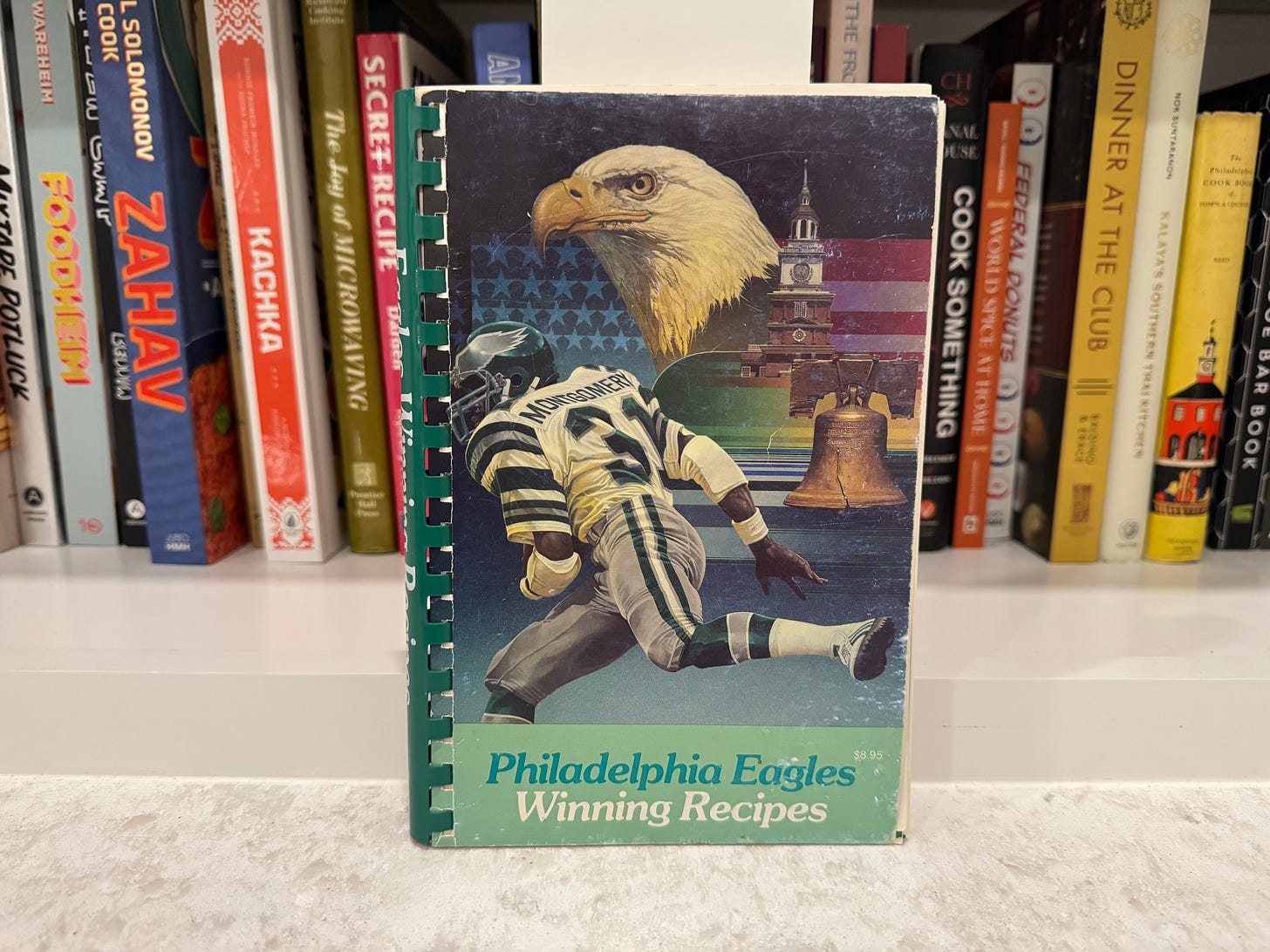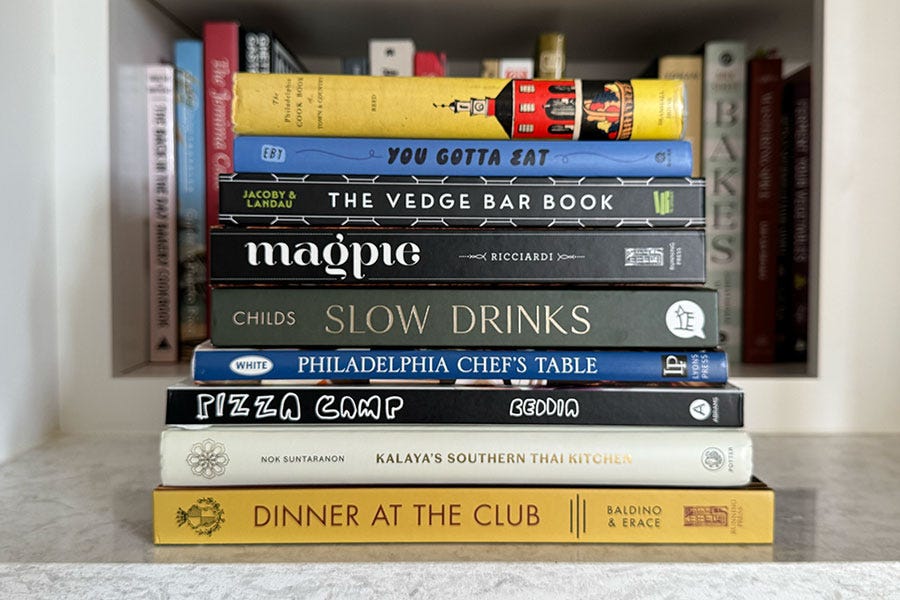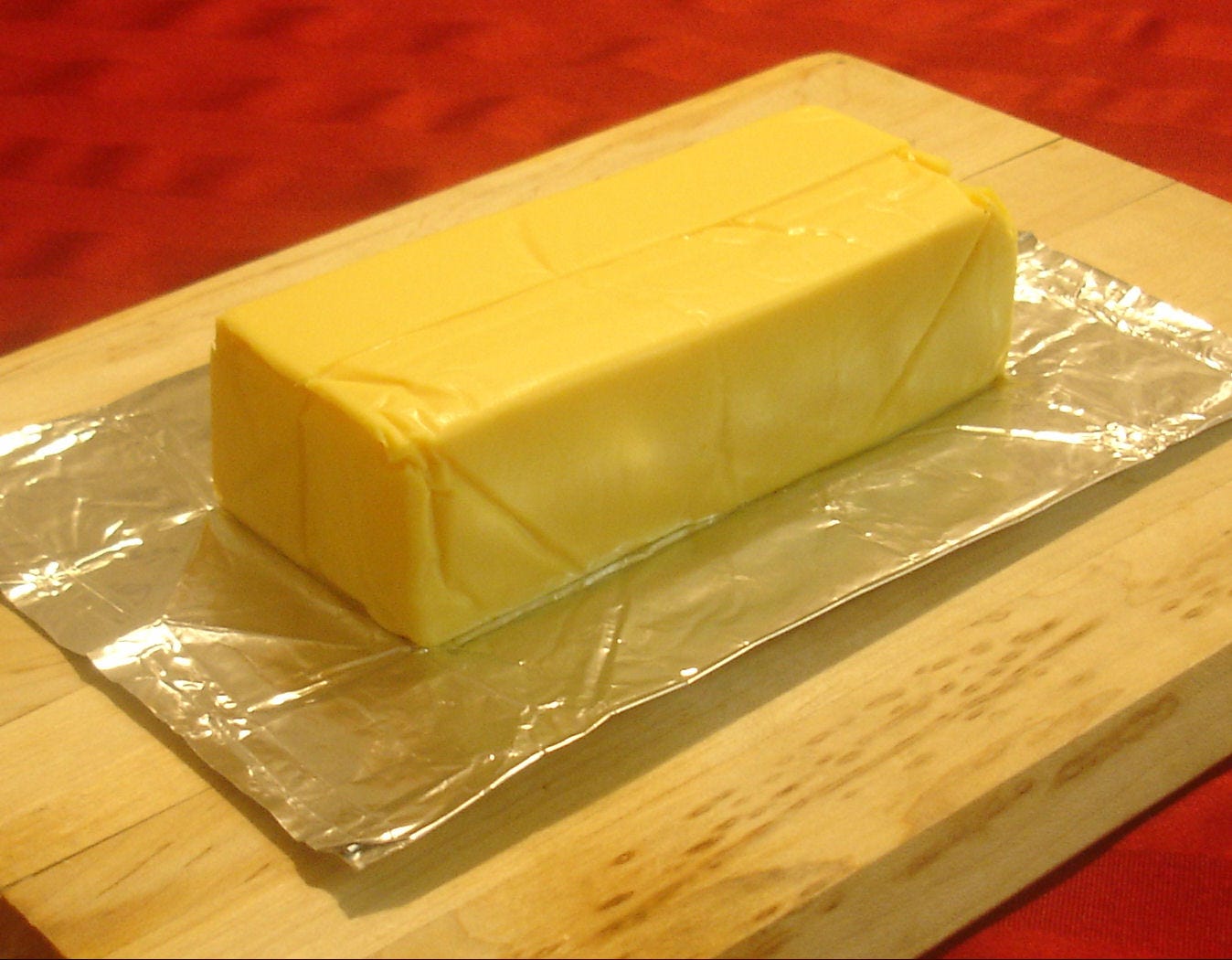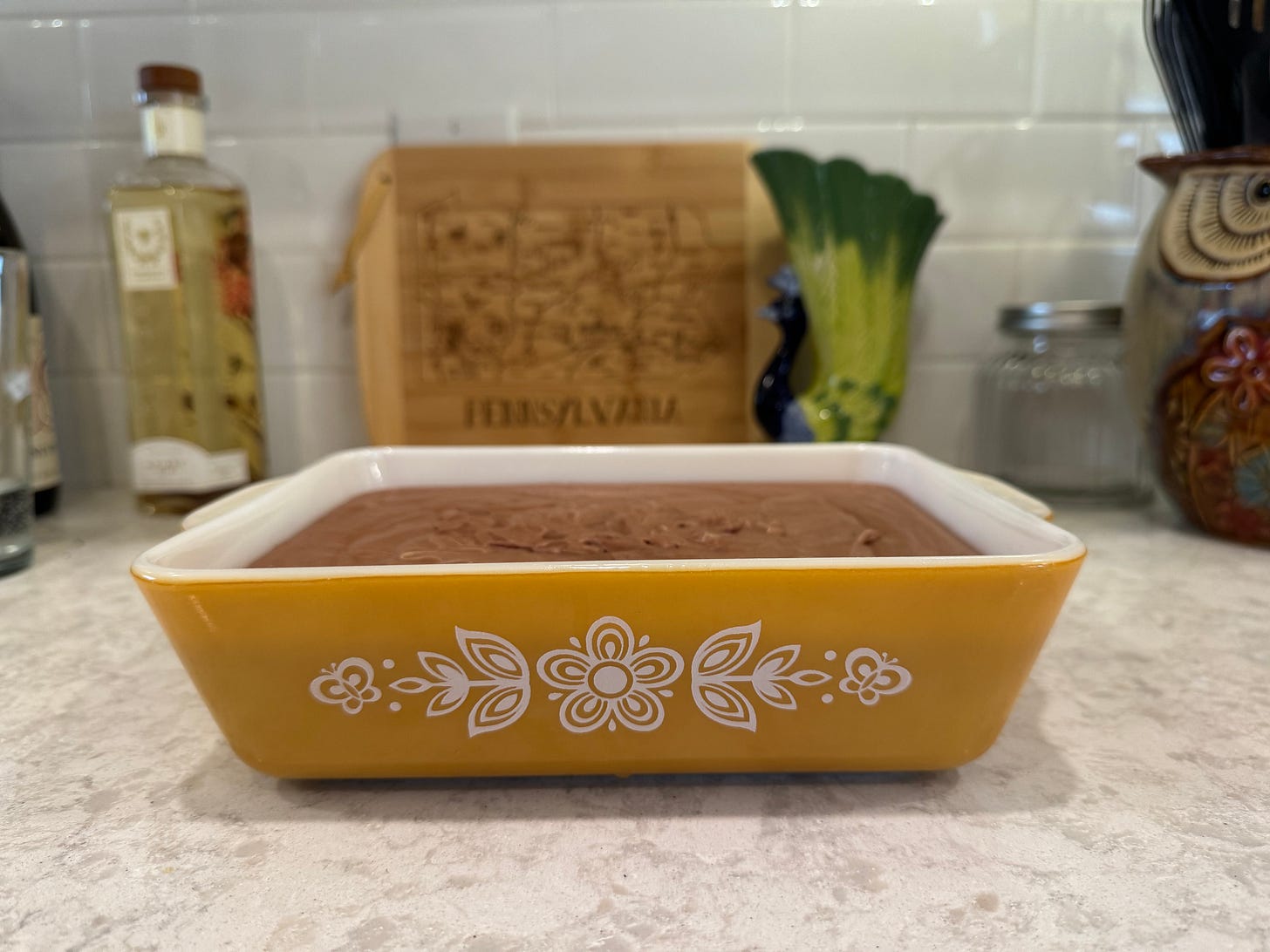Fumbling Through The Philadelphia Eagles Winning Recipes Cookbook
Microwave fudge, chili con cheese product, and New Orleans-style red beans and rice, courtesy of the 1980-1981 Super Bowl team.

Editor’s note: I originally said the Eagles won the Super Bowl in 1981. They did not! It was part wishful thinking and part mixing up the Phillies win. What do you want from me?! I’m a food nerd, not a sports nerd.
My husband, Jon, and I represent two different kinds of collectors. Jon is your classic nerdy type—the kind that has compiled a menagerie of pop-culture ephemera and objects of rare curiosity (like the coveted x-rated Star Wars “Golden Rod” error card that looks like C-3PO is very excited to see you).
I, on the other hand, am a hoarder of knowledge—a purveyor of random facts and trivia that, aside from engineering hyper-specific contexts within my writing to sneak them in, are only useful when watching Jeopardy and playing Quizzo.
When applied to my love of food history and culture, this collecting habit has manifested itself in the form of a vast library of cookbooks. I love my collection—so much so that when I remodeled my kitchen, I asked our contractor to design a bookshelf so that I could put my passions on display in my favorite room in the house.
I’ve got the essentials like the Joy of Cooking (who has a delightful newsletter here on Substack! Go check it out
) and various editions of the Betty Crocker Cookbook, but the more obscure titles I own are the most fascinating. The Beanie Baby Handbook: Includes 52 Fabulous Recipes, The Biker Cookbook: More than 100 Recipes from America's Hungriest Motorcycle Enthusiasts, and KFC Secret Recipes are a few of my favorites (and yes, they are real).Roughly half of my collection, though, are Philadelphia cookbooks. To me, they’re like culinary encyclopedias documenting the intricate foodways that connect Philly with the rest of the world. “As a food editor, they’re a valuable resource for better understanding our local scene and the people creating it,” I wrote in a recent Philly Mag guide to Philadelphia’s best cookbooks. “Though restaurants and chefs come and go, their contributions can still be found in print, ready to be studied and savored for years to come.”
While searching my library for the most influential and impactful titles to feature, Jon asked if I had any focused on the Eagles. “It would be a great one to add considering they just got into the playoffs,” he said. He was right; Philly would eat up the idea of an Eagles cookbook (pun 100 percent intended).
My collection, unfortunately, lacked a compendium documenting the food that fuels the birds and their fans. But after a quick Google search, Jon found one: Philadelphia Eagles Winning Recipes.
Just as the James Beard Award-winning tomes on my kitchen bookshelf preserve the cultural significance of cuisines woven into the fabric of American identity, the more esoteric books preserve something that I find equally captivating—super niche subcultures. And a spiral-bound community cookbook containing the go-to recipes of the coaches, players, and wives of the 1980-1981 Eagles team (who went to the Super Bowl and sadly lost) is as niche as you can get. “This,” I said, “is the Holy Grail of Philly cookbooks.”
Now, you might be saying, Kae Lani, Philadelphia Eagles Winning Recipes isn’t on Philly Mag’s list. Why are you holding out on us?
Well, first I had to secure a copy for myself. It was only printed once in 1980 and sold to raise money for Eagles Fly For Leukemia. The only ways you’re likely to come across this one are if you strike gold at a second-hand bookshop or search for it at the exact moment someone posts it online. I lucked out and spent a whopping $50 on the only copy I could find on eBay. It also happens to be signed by the editor Carol Vermeil, which, for me, as a collector, made the find even more exciting. Second, I wanted to test the recipes before putting my reputation as a food editor on the line.
REVIEW: Philadelphia Eagles Winning Recipes
The very first recipe, written by Wilbert Montgomery, a running back for the Eagles from 1977 to 1984, is for All Purpose Dip. It contains two ingredients: a 16-ounce carton of sour cream and one package of Knoor Swiss Vegetable Soupmix. And that should tell you immediately where we are in space and time with this one. This book is a flashback to a bygone era of party dips, postmodern hors d’oeuvres, quick breads, and potluck casseroles where the featured ingredients are from major brands like Miracle Whip, Campbell’s Soup, and Frito-Lay, the sponsor of Philadelphia Eagles Winning Recipes, and the main ingredient in virtually every recipe in the last chapter, simply titled “Mexican.”
This is 1980: the beginning of what is referred to as “the decade of decadence,” marked by technological advancements, convenience, and consumerism, after all. A generation before, Dorcas Reilly, the first employee of Campbell’s Home Economics department, invented the green bean casserole in 1955. It was the first time the company repurposed one of their products as an ingredient in an easy-to-make recipe for the modern homemaker, and certainly not the last.
Through the 1960s, a proliferation of branded recipes and instant foods entered the market. Instant noodles just hit the shelves across America, Tang fueled astronauts on the moon (decades later, Buzz Aldrin admitted that the orange drink “sucks”), and potlucks hit peak popularity. This coincided with the rise of the big-box grocery store as well as the mass production and national distribution of pre-made products, ensuring that dishes like Rice-a-Roni were no longer limited to being a San Francisco treat but rather a staple in homes across the country. This was the future of food: an era of convenience that preceded “the decade of decadence.”
That should give you a sense of the culinary chaos that is the Philadelphia Eagles Winning Recipes cookbook.
Now, there are some recipes that I’m too afraid to try, like the Hot Clam and Cheese Dip by Chris Morriss, a key player on the team’s offensive line, and Sandie Krepfle’s Crabmeat Dip, which calls for one cup of Miracle Whip. For obvious reasons, hot seafood mixed with cheese and/or mayonnaise substitutes does not sound appetizing.
I did, however, attempt Eagles running back Billy Campfield’s Chili Con Queso, and it was a disaster. The recipe called for a four-ounce can of diced green chilies, a one-pound can of whole tomatoes, drained and finely chopped, and an entire pound of Velveeta cheese. I find it funny that they used the word “cheese,” considering it doesn’t meet the 51 percent cheese curd requirement to be classified as such, per the FDA. I’m not a fan of Velveeta, so I tried to swap it for real cheddar, and it resulted in a goopy mess that just tasted like wet cheese with tomato juice. However, I’m not sure if using Velveeta would have saved this recipe. The proportions are all off. When I eat chili con queso, I want to be hit with spice. And when that four-ounce can of green chilies is mixed with one pound of tomatoes and one pound of Velveeta, it gets lost.
The out-of-whack proportions of these recipes continued to confound me as I embarked on Patti Key’s No-Fail Microwave Fudge. Three cups of sugar, 2/3 cup of evaporated milk, two cups of semi-sweet chocolate, two cups of marshmallow cream, a single teaspoon of vanilla, and a whopping 3/4 cup of butter. I puzzled over that last ingredient for a while. 3/4 cup of butter—a stick and a half of butter—felt like way too much.
I went ahead with it anyway, afraid that I’d muck it up if I dared to alter the recipe, just as I had done with the Velveeta chili con queso. I had to stick to the plan—trust the process. The instructions said to microwave the butter, evaporated milk, and sugar for eight minutes. But how powerful is eight 1980 microwave minutes? How do you account for advancements in modern technology? Judging by how the molten butter and sugar lava erupted from the plastic bowl with just two minutes and 18 seconds left on the clock, I’m assuming five to six minutes is the correct conversion rate. I mixed in the semi-sweet chocolate chips, marshmallow cream, and vanilla with what I was able to salvage from the microwave mess and poured it into my vintage Pyrex Buttyfly Gold casserole dish.
The verdict? It’s more mousse than it is fudge, and you can feel every crunchy grain of sugar. In terms of flavor, it’s overly sweet, and the butter overpowers the chocolate. This is the kind of thing you bring to a potluck if you never want to be invited to a potluck ever again.
The last recipe I tried was Petey Perot’s Red Beans and Rice—New Orleans Style. Funny enough, there are two red beans and rice recipes in this cookbook, and they’re both in the Main Dishes and Casseroles chapter. But this isn’t the only repeat recipe: there are three different kinds of fudge, several versions of chili, a handful of broccoli casseroles, and way too many crab dips.
I opted for Petey Perot’s recipe because he’s from Louisiana, and since the Eagles are playing the Super Bowl in The Big Easy, this was a no-brainer. There is, however, one glaring omission from the offensive lineman’s take on this Creole classic: there is no Andouille sausage. It only calls for 1/2 pound of salt pork, pickled pork, or ham hock.
Was this a time before the tradewinds brought Andouille up to Philly from the Mississippi? Is this a quirk of a Perot family recipe? I have no clue because unlike many cookbooks today where recipes are accompanied with stories that explain the chefs intentions, Philadelphia Eagles Winning Recipes offers zero context. Just a list of ingredients, sparse instructions, and every few pages, an inspirational quote by a famous Philadelphian. At the bottom of Perot’s red beans and rice recipe, a quote from Ben Franklin reads, “Diligence is the mother of good luck!”
Prep was easy: Chop up your mirepoix, the “Holy Trinity” of carrots, onion, and celery; brown the ham; set it aside; and make a roux from the drippings. Then add herbs, simmer everything in chicken stock for an hour or so, and serve over rice.
It’s not bad. Not great. But not bad! It really needs Andouille. But if you need a filling, crowd-pleasing dish with muted flavors that your guests can add hot sauce to if they need, then this dish is a success.
Overall, you don’t get this cookbook for the food. The people who penned these recipes are not chefs; they’re NFL champs who are way better on the field than they are in the kitchen. No—you get this for the novelty. Philadelphia Eagles Winning Recipes is for when you want to show up to the Super Bowl watch party with a mediocre dish and one helluva story about how a ragtag team of footballers from the City of Brotherly Love decided to immortalize their first time going to the Super Bowl in the form of a community cookbook—a Hail Mary of a project that, even though they lost, is a game-winning touchdown.







